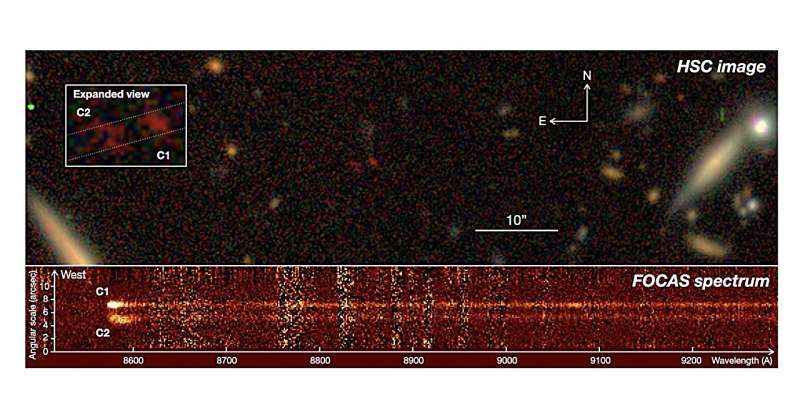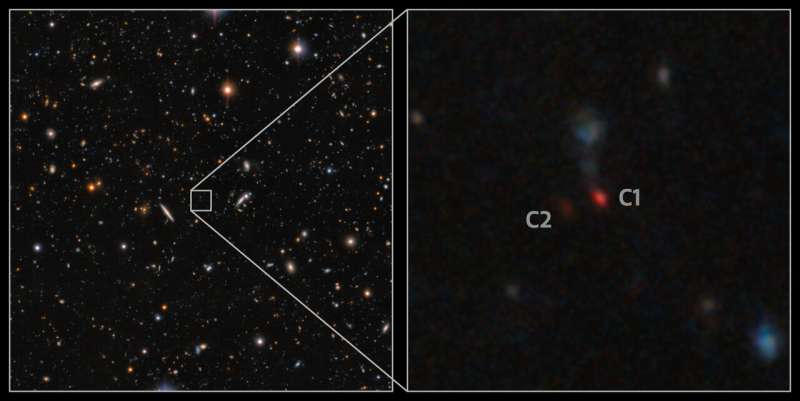May 15, 2024 report
This article has been reviewed according to Science X's editorial process and policies. Editors have highlighted the following attributes while ensuring the content's credibility:
fact-checked
peer-reviewed publication
trusted source
proofread
Astronomers discover merging twin quasars

Using the Subaru Telescope in Hawaii, astronomers have detected a pair of merging quasars at a high redshift, as part of the Hyper SuprimeCam (HSC) Subaru Strategic Program (SPP) survey. The serendipitous discovery is reported in the latest issue of the Astrophysical Journal Letters.
Quasars, or quasi-stellar objects (QSOs), are active galactic nuclei (AGN) of very high luminosity, emitting electromagnetic radiation observable in radio, infrared, visible, ultraviolet and X-ray wavelengths. They are among the brightest and most distant objects in the known universe, and serve as fundamental tools for numerous studies in astrophysics as well as cosmology.
For instance, quasars have been used to investigate the large-scale structure of the universe and the era of reionization. They have also improved our understanding of the dynamics of supermassive black holes and the intergalactic medium.
Recently, a team of astronomers led by Yoshiki Matsuoka of the Ehime University in Japan has analyzed the deep multi-band imaging data collected by HSC-SPP. Combing through the data, they serendipitously detected two merging quasars, which received designations HSC J121503.42−014858.7 (C1) and HSC J121503.55−014859.3 (C2).
According to the study, the two quasars are separated by approximately 39,000 light years and are likely in physical association with each other. The observations detected extended Lyman-alpha emission bridging C1 and C2, as well as various extended structures in other emission lines.
The astronomers underlined that the bridging emission structures indicate that these two quasars are undergoing a merger. Therefore, given that C1 and C2 are at a redshift of 6.05, they are the most distant merging quasars so far detected.
The study found that C1 and C2 have rest-frame ultraviolet absolute magnitudes of -23.1 and -22.6, respectively. The bolometric luminosity of C1 was measured to be 6.2 quattuordecillion erg/s, while in the case of C2 it turned out to be lower—4.1 quattuordecillion erg/s. The study also notes that the two quasars most likely have supermassive black holes (SMBH) with similar masses.

Summing up the results, the authors of the paper noted that they are still investigating the merger of the newly detected quasar and will present more detailed results shortly.
"A companion paper will present the gas and dust properties captured by Atacama Large Millimeter/submillimeter Array observations, which provide additional evidence for and detailed measurements of the merger and also demonstrate that the two sources are not gravitationally-lensed images of a single quasar," the scientists wrote.
More information: Yoshiki Matsuoka et al., Discovery of Merging Twin Quasars at z = 6.05, Astrophysical Journal Letters (2024). DOI: 10.3847/2041-8213/ad35c7
Journal information: Astrophysical Journal Letters
© 2024 Science X Network





















